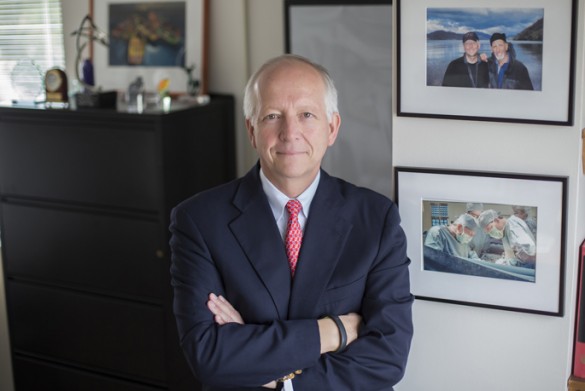
Douglas Hanto, M.D., Ph.D., has his sights on Monroe Carell Jr. Children’s Hospital at Vanderbilt.
No stranger to building nationally recognized liver transplant programs — he has three under his belt — the new associate director of the Vanderbilt Transplant Center aims to work with the departments of Pediatrics and Surgery to develop a comprehensive pediatric liver center at Children’s Hospital.
“There is no better place in Tennessee than Children’s Hospital to care for infants, young children and adolescents who have liver disease, and that should include the option of liver transplantation,” said Hanto. “The Vanderbilt Transplant Center has always had a spectacular reputation both nationally and internationally. Similarly, so does Children’s Hospital.
“Our goal to build a liver center that would include medical, surgical and transplant components. Not only is there a need for such a program,” he said, “but the expertise and support are already here to move forward with plans to further develop this center.”
Hanto expects the pediatric liver transplant program to be operational by April.
Although his focus will be establishing the comprehensive pediatric liver center, a big organizational effort, he is looking forward to doing what he loves most — operating and taking care of patients.
It’s been a dream of his since he was in the 7th grade when he had his appendix removed. Initially he planned to become a cardiac surgeon, but after his first internship rotation in transplantation, he never looked back.
“I became very excited about transplant as the new frontier. I still am.”
Hanto comes to Vanderbilt from Washington University School of Medicine in St. Louis, where he was professor of Surgery and associate dean for Continuing Medical Education. Prior to that he was chief of the Division of Transplantation at Beth Israel Deaconess Medical Center in Boston and Lewis Thomas Professor of Surgery at Harvard Medical School for 11 years. He also helped start liver transplant programs at the University of Cincinnati and at Washington University in St. Louis.
Graduating magna cum laude with a bachelor’s degree from St. Olaf College, Hanto was first in his class at the University of Arizona College of Medicine.
He completed his general surgery and transplant training and earned a Ph.D. at the University of Minnesota in Minneapolis.
He has held numerous leadership positions in national and international professional surgical and transplant societies and boards. He has also published more than 230 articles and book chapters.
“Dr. Hanto is an international leader in transplantation and will be an extraordinary presence at Vanderbilt,” said Seth Karp, M.D., director of the Vanderbilt Transplant Center. “Over his distinguished career he has made remarkable contributions to the field of transplantation in both the basic science and clinical realms.”
“We are fortunate to have Dr. Hanto join our faculty. I know he will build an outstanding program to serve our children with liver failure,” added John W. Brock III, M.D., Monroe Carell Jr. Professor, Children’s Hospital Surgeon-in-Chief and director of the Division of Pediatric Urology.
“His experience not only in surgical care but in team building will allow us to further enhance the care we provide for our patients and families.”
Hanto will also continue his research into the ability of inhaled carbon monoxide (CO) at low concentrations to improve delayed graft function, allograft rejection and survival in kidney transplantation. Using animal models, it has been shown that the treatment is effective in restoring kidney function more rapidly.
The method is presently being studied in the kidney, but Hanto hopes to expand the studies to include all transplanted organs.












